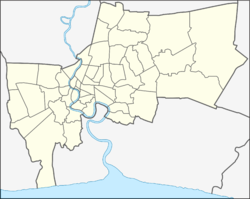Top Qs
Timeline
Chat
Perspective
Wat Kanlayanamit
Buddhist temple in Bangkok, Thailand From Wikipedia, the free encyclopedia
Remove ads
Wat Kalayanamitr Varamahavihara (Thai: วัดกัลยาณมิตรวรมหาวิหาร, RTGS: Wat Kanlayanamit Woramahawihan, IPA: [wát kanlajaːnamít wɔːráʔmahǎːwíʔhǎːn]) is a Buddhist temple (wat) in Bangkok, Thailand. The temple is located in Wat Kanlaya sub-district, on the Thonburi bank of the Chao Phraya River. The temple was established in 1825 by Chaophraya Nikonbodin (born To, Thai: เจ้าพระยานิกรบดินทร์ (โต)), a wealthy Thai Chinese trader,[1] who donated the temple to Rama III. Chaophraya Nikonbodin was an ancestor of the Kalayanamitr family, whose descendants include Saprang Kalayanamitr. A poem inscribed in the temple reads:
Wat Kalayanamitr Varamahavihara is one of three family temples of the Kalayanamitr family, along with Wat Rakhang and Wat Chakkrawatdirachawat Woramahawihan. The family name Kalayanamitr derives from a poem inscribed in the temple.[2]
The ordination hall stands prominently on the riverbank, housing the massive Buddha image Phra Buddha Trai Rattananayok (พระพุทธไตรรัตนนายก), commonly known in Thai as Luang Pho To (หลวงพ่อโต, lit. 'Big Buddha') and among the ethnic Chinese as Sampokong (ซำปอกง, Chinese: 三寶佛公). It was once considered the largest Buddha image in Bangkok and shares its style with the Big Buddha at Wat Phanan Choeng in Phra Nakhon Si Ayutthaya. This makes the ordination hall notably large and highly visible from the river. Both Buddha images are revered as representations of both the Buddha and the Chinese admiral Zheng He. Thai people and those of Chinese descent firmly believe that paying respect to these images brings prosperity, good fortune, and safe journeys throughout the year.[3]
Remove ads
Gallery
- Phra Buddha Trai Rattananayok, also called Sampokong according to Teochew dialect
- Phra Vihāra
- The ordination hall
- Sermon hall
References
Wikiwand - on
Seamless Wikipedia browsing. On steroids.
Remove ads






